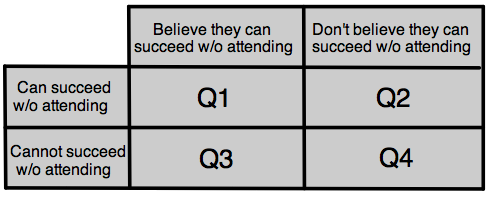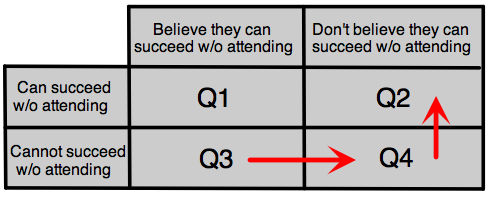Every semester I have a contingent of students who don’t attend class. Let’s break down the class composition according to attendance and consider each quadrant.

Here are my observations:
Q3 is a problem. Q1, Q2, and Q4 are manageable. For Q1 and Q4, perception = reality.
Q1 students can easily learn the material from the book and many don’t bother taking notes in class. A few of these make near-perfect scores on every exam. These students are probably smarter than I am because I was never able to do this. I often never get to know these students because they have little need for office hours. It doesn’t bother me that they miss class. The possibility of Q1 success may mean my class is too reliant on a textbook, but that’s another discussion.
Q2 students probably prefer learning from lectures than reading the textbook, so they’d rather get their information in class and only use the book when absolutely necessary. They are often really bright and could easily grasp the material independently with a little more concentration.
Q2 students are really fun to interact with in office hours. Sometimes they show up confused with questions, but quickly understand explanations. I can often go into a lot more detail with them outside of class and challenge them in fun ways.
Q3 and Q4 students may possess a combination of a weaker academic background, lower reading comprehension, or simple lack of effort/discipline. Whatever the cause, they are unable to both skip class and learn the material on their own. This is not necessarily bad.
Q4 students have made peace with this and diligently attend class. They are also very active in office hours and are the students where I consistently see the most growth during a semester. Many of them are extremely hard working.
Q4 students, with the right combination of mentoring and disciplined effort, can move into Q2 and do very well. Example: I have had two students in this category fail the first exam and make the high score on the final.
Q3 students often think they are Q1 students. It’s painful to watch. Despite evidence to the contrary (i.e. failed tests), they remain in Q3 instead of adjusting their behavior to the more healthy Q4. Almost every student who has ever failed my course is in this category.
Q3 students seem to require a major intervention to shift into Q4, where they would likely do very well. An example intervention might be the threat from losing a scholarship or even being dropped from enrollment, although I have seen multiple cases where even these factors weren’t sufficient to motivate change.
Q3 students are also a source of internal tension for me. On the one hand, I really want to help them succeed. In fact, I will spend countless office hours working students who are struggling but want to succeed. But on the other hand, part of me has to admit that maybe they’d better serve society in a capacity other than a structural or aerospace engineer.
In conclusion, my goal as an instructor is to help transform Q3 students into Q4 students, and to transform Q4 students into Q2 students. Whether a Q2 student decides to venture into Q1 territory, I’m not too worried about.

If you are one of my students, you should know that I place a high value on personal responsibility and hope the above rubric might help some of you self-assess where you stand and make great decisions regarding how you try to learn the material I am teaching.
And for you seasoned professors out there, I’d love to know if you have any advice on how to advance Q3 students into healthier habits.